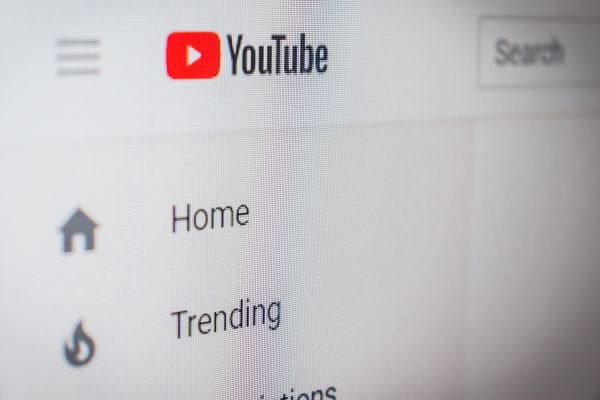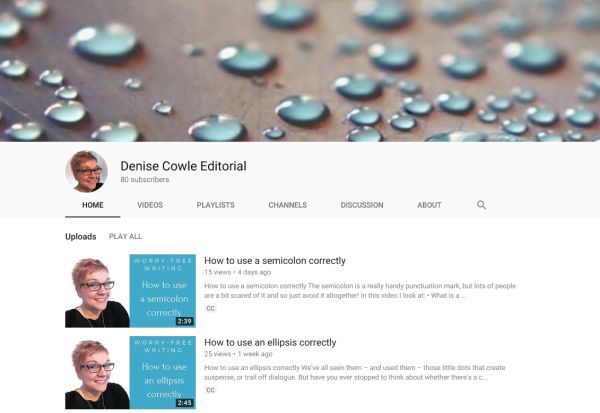In the second instalment of our ‘Editors and social media’ series, Denise Cowle explains why and how she uses YouTube for her business, and how that fits in with her use of other social media.
When and why did you start?
In 2015 I went to a conference run by the Content Marketing Academy, where there was a workshop by Marcus Sheridan. It showed me that there was so much more I could be doing to promote my business online. I was full of enthusiasm and started blogging regularly and using social media to promote it and engage with lots of people, both editors and potential clients.
Since then I have embraced lots of new things, most recently taking part in a challenge which saw me produce one video each week for 13 weeks.
I’ve only been using video for a few months, but the results have been very positive so far.
What do you share?
I share my latest blog or video every week, plus I rotate through older content which still has value. Most of the stuff I create doesn’t date (it’s evergreen, to use a buzzword!) so it’s still relevant months or even years after it’s written or filmed. People aren’t necessarily going to find it directly from searching, so it’s good practice to put it out there at regular intervals to show what you have.
I don’t just share my own content – I read other blogs and websites, and there is a lot of really useful information worth sharing. I think if you share the good stuff it goes a little way towards pushing the useless stuff further down people’s newsfeeds!
When do you share?
Depending on the platform, I’ll share/post every day or several times a day, using a scheduling tool (Buffer) to automatically share my own content and other links that I’ve spotted but don’t necessarily want to share when I first see them. But I also spend a little time every day engaging with other people, liking, sharing and commenting on their posts as they appear in my timeline.
I find blogging quite time-intensive. It can take me four or five hours to write a blog, edit it, find or create the right images, and then do all the behind-the-scenes work for SEO, like adding links, meta-description, social share buttons and the sign-up buttons for my newsletter.
I’ve been surprised at how quickly I got into a rhythm for video production – it doesn’t take nearly as long to produce, as I can now film, edit and upload a five-minute video in around two hours, including all the SEO and techy things (like creating a custom thumbnail and choosing the right tags for that post) and the on-screen titles, cards and subtitles.
Why do you do it?
It’s actually given me a lot of confidence – the first few videos I created were pretty dodgy, but I kept going and picked up advice on improving the technical aspect of it and the presentation skills needed for talking to my iPhone while it’s balanced on a pile of books on a stepladder (you can manage perfectly well without high-tech equipment!)
Generally, I keep motivated by the feedback I get from people who enjoy what I produce and share it. More importantly, when clients tell me they read my blog or saw my video, that tells me that I’m doing the right thing. Writing or creating videos about editing-related topics shows people I know what I’m doing, rather than me just telling them that!
The videos have been incredibly effective, particularly when I upload them natively to LinkedIn (natively means publishing the video directly on that platform, rather than posting a link to the video on my YouTube channel). I got several new clients directly as a result of them seeing my videos. One was a global publisher I hadn’t worked with until now, and another was an edtech company who asked me to reshoot one of my videos for them, so they could use it in one of their courses! Now THAT was something I didn’t see coming!
Getting concrete results like that is all the motivation I need!
What about other social media platforms?
Although my videos are created for my YouTube channel, that’s not primarily where people will go to look for them, so I upload them to LinkedIn, which has far and away been the most effective platform in terms of engagement and actual sales, and I share on Twitter and my Facebook page. It sounds like a lot but only takes a matter of minutes to do.
Any advice?
I would encourage anyone to have a go at video. If you have a decent phone and somewhere quiet to record, that’s enough to get started. I dipped my toe in the water with some Facebook Live broadcasts last year, just to get used to speaking to camera. I also watched quite a few online tutorials about getting started, which gave me lots of helpful tips, particularly about setting up my YouTube channel.
And it doesn’t have to be perfect – I’ve left bloopers in and made a feature of them. Video is a great way of showing your personality – you know you’re fabulous, and now your prospective clients can see that too!
 Denise Cowle is an editor and proofreader based in Glasgow. She specialises in non-fiction, particularly education and business, and edits for a variety of global publishers, companies and organisations.
Denise Cowle is an editor and proofreader based in Glasgow. She specialises in non-fiction, particularly education and business, and edits for a variety of global publishers, companies and organisations.
She has an interest in continuing professional development and content marketing, and when she’s got spare time she loiters on social media and writes her blog.
Denise is an Advanced Professional Member of the Society for Editors and Proofreaders and is also its Marketing and PR Director.
Posted by Abi Saffrey, SfEP blog coordinator.
The views expressed here do not necessarily reflect those of the SfEP.







 Louise Harnby is a fiction line editor, copy-editor and proofreader who specialises in supporting self-publishing authors, particularly crime writers. She is an Advanced Professional Member of the Society for Editors and Proofreaders (SfEP) and an Author Member of The Alliance of Independent Authors (ALLi). Find out more at
Louise Harnby is a fiction line editor, copy-editor and proofreader who specialises in supporting self-publishing authors, particularly crime writers. She is an Advanced Professional Member of the Society for Editors and Proofreaders (SfEP) and an Author Member of The Alliance of Independent Authors (ALLi). Find out more at 












